Dud Corner Cemetery, Loos-en-Gohelle, France
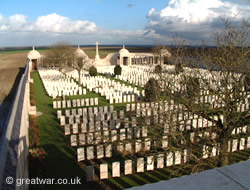
|
There are 1,800 burials of British and Commonwealth officers and men at Dud Corner Cemetery, Loos. Of this number, only 684 of the burials are identified, leaving over 1,100 of the burials identified only as British or Commonwealth servicemen.
The majority of the burials at Dud Corner were killed or died of wounds on the battlefield during the Battle of Loos (25 September - 13 October 1915). Some graves, known and unknown, are also for British and Canadian servicemen who died in the area after that time until the Armistice. The Allied and German Front Lines more or less stabilized here for the following three years after the Battle of Loos until the later months of 1918 when Allied offensives gradually pushed the Germans eastwards in the Allied Advance to Victory (8 August - 11 November 1918).
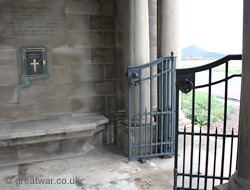
|
In mid 1917 the Canadian Corps mounted an offensive against the German line east of Loos in the Battle of Hill 70 (15 - 25 August 1917), with the objective to draw the Germans to this place at the start of the Allied offensive further north in the Ypres Salient. The Canadians suffered several thousand casualties of killed, wounded and captured in that battle action.
Both the Battle of Loos and the Battle of Hill 70 were battles where gas was used as a weapon of war. At the start of the Battle of Loos the British First Army released clouds of poisonous chlorine gas towards the German Front Line trenches. This was the first use of gas on the Western Front by the British Army. Its success was varied as a result of inconsistent wind and complications with the release of it on the day. In the Battle of Hill 70 the Canadians and the Germans used poisonous gases against one another.
Origin of Dud Corner Cemetery
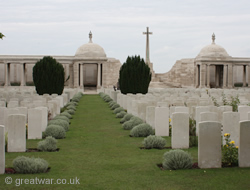
|
Dud Corner Cemetery is on the site of the “Lens Road Redoubt”, known as such on British Army maps. This was a German strongpoint in the German Front Line on the crest of a gentle rise on the Lens-Vermelles road.
A 1915 trench map (1), scale 1:10,000, used by a British officer at the Battle of Loos in September-October 1915 shows the “Lens Road Redoubt” located on the 70 metre contour line, just below the crest of the hill on the Lens-Béthune road. For the British looking up at the higher ground from the British lines some two hundred metres distant, the redoubt was hidden from view on the reverse slope. The distance of No-Man's-Land between the British and German Front Lines in the Loos sector up to 25 September 1915 varied from a distance of 200 metres to as wide as 900 metres in places.
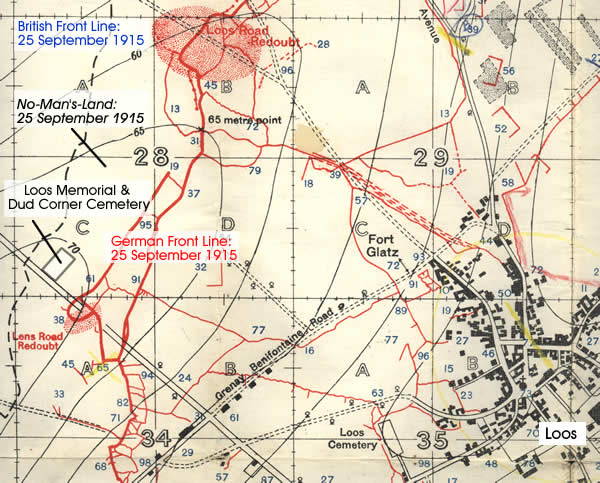
During the 1914-1918 war there were five British burials in this location near the redoubt. On the first day of the Battle of Loos the 15th Scottish Division successfully broke through the German Front Line and overran the Lens Road Redoubt. By the end of the battle in mid October 1915 the British Front Line was located to the east of Loos village, and the Lens Road Redoubt remained in British hands behind the British Front Line for the rest of the war. The original burials located in this place at the end of the war were four officers of the 9th Battalion Black Watch and one Private of the 8th Battalion Royal Dublin Fusiliers. They are currently located close to Plot III, Row B.
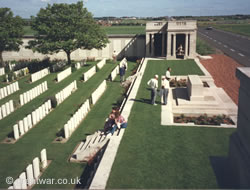
|
When the burial parties came to the area after the war to search the battlefield around and north of Loos, the remains of 1,800 casualties were brought to this place. The origin of the name is believed to have been because there were lots of dud artillery ammunition shells found in the location after the war ended, hence the name “Dud Corner”. Mostly the casualties' remains were brought here from single battlefield burials or small groups of burials. Three small burial sites were exhumed and the graves were brought to this cemetery for reburial. These sites were:
- Tosh Cemetery, Loos: This site was on the north side of Loos village. It was named after the nearby communication trench called “Tosh Alley”. There were 171 soldiers from the United Kingdom (118 of whom were Irish) and five from Canada buried here. Tosh Cemetery had been in use between October 1915 and September 1917.
- Crucifix Cemetery, Loos: This cemetery was orginally located to the west of Tosh Cemetery. It was in use between September 1915 and May 1916. There were 53 soldiers from the United Kingdom buried there.
- Le Rutoire British Cemetery, Vermelles: This cemetery was near to Le Rutoire Farm. The farm was, and still is, on the plain of Loos, east of the village of Vermelles. The cemetery was in use in 1915, and contained the graves of 82 soldiers from the United Kingdom. Six French soldiers were also buried there.
There are 15 special headstones in the cemetery, located to the left of the Great Cross. They commemorate 15 soldiers from the United Kingdom who are believed to be buried among the casualties brought to Dud Corner cemetery after the war.
To the right of the Great Cross there are special memorials to twelve soldiers of the 2nd Battalion the Welch Regiment. They were killed in action on the 12 October 1915 at the very end of the Battle of Loos. Originally they were buried in Crucifix Cemetery, Loos. At the time of the exhumation of the graves in Crucifix Cemetery to bring them to Dud Corner the identified remains of these 12 soldiers could not be found.
Design of Dud Corner Cemetery
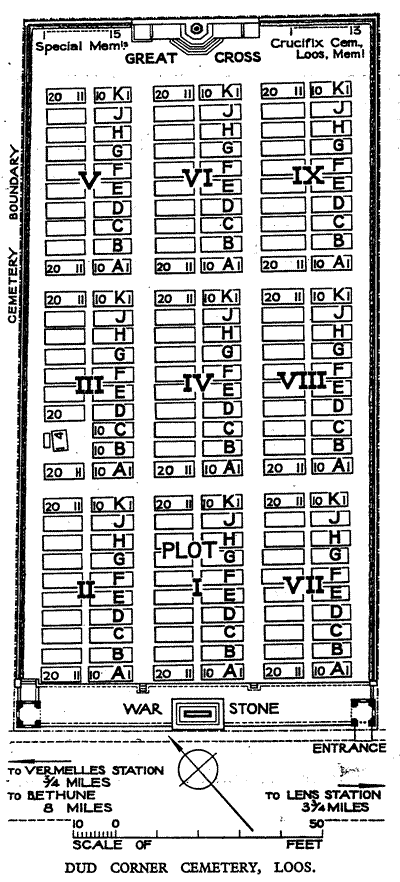
The graves at Dud Corner are located inside the boundary of the two side walls and the rear wall which forms the Loos Memorial to the Missing.
There are nine plots identified by Roman numerals I to IX. Each plot contains the remains of 200 casualties laid out in 10 rows of 20 graves in each row.
The Great Cross, the Cross of Sacrifice, is located at the eastern end of the cemetery.
The plan of the cemetery is courtesy of the Commonwealth War Graves Commission. (CWGC)
Dud Corner Cemetery Location
Dud Corner Cemetery and Loos Memorial is located on the N943 Lens-Béthune road. It is north-west of the village of Loos-en-Gohelle.
Access
The cemetery and memorial are accessible to the public daily and there are no opening hours.
There is a parking pull off area off the main road at the front (west side) of the memorial and cemetery. Visitors are advised to be extremely careful when getting in and out of a car on the side nearest the road. The Lens-Béthune road can be busy but even when it is not, vehicles are often travelling at high speed and the tail winds can be dangerous for people moving about around cars parked by the memorial.
Related Topic
Loos Memorial
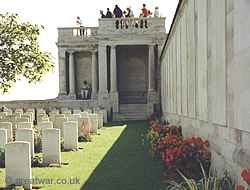
|
The Loos Memorial to 20,065 Missing British and Commonwealth officers and men forms the two side walls and the rear wall of Dud Corner Cemetery:
Acknowledgements
(1) British Army map 36C N.W. Sheet 3 & Part of 1, trenches corrected to 25 August 1915, scale 1:10,000. Private collection.
(CWGC) Cemetery plan by kind permission of the Commonwealth War Graves Commission:
Website: www.cwgc.org
